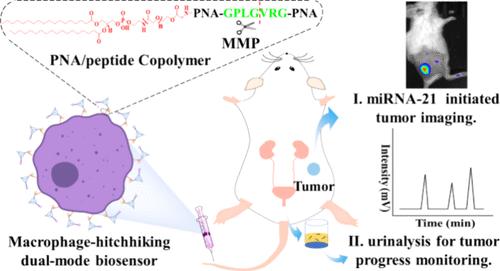当前位置:
X-MOL 学术
›
J. Am. Chem. Soc.
›
论文详情
Our official English website, www.x-mol.net, welcomes your
feedback! (Note: you will need to create a separate account there.)
A Multifunctional Peptide Nucleic Acid/Peptide Copolymer-Based Dual-Mode Biosensor with Macrophage-Hitchhiking for Enhanced Tumor Imaging and Urinalysis
Journal of the American Chemical Society ( IF 14.4 ) Pub Date : 2024-11-20 , DOI: 10.1021/jacs.4c10562 Kaiji Wei, Yu Xu, Cunpeng Nie, Qiaomei Wei, Ping Xie, Tingting Chen, Jianhui Jiang, Xia Chu
Journal of the American Chemical Society ( IF 14.4 ) Pub Date : 2024-11-20 , DOI: 10.1021/jacs.4c10562 Kaiji Wei, Yu Xu, Cunpeng Nie, Qiaomei Wei, Ping Xie, Tingting Chen, Jianhui Jiang, Xia Chu

|
Biosensors are capable of diagnosing tumors through imaging in vivoor liquid biopsy, but they face the challenges of inefficient delivery into tumor sites and the lack of reliable tumor-associated biomarkers. Herein, we constructed a dual-mode biosensor based on a multifunctional peptide nucleic acid (PNA)/peptide copolymer and DNA tetrahedron for tumor imaging and urinalysis. The biosensor could enter the cancer cells to initiate a microRNA-21-specific catalytic hairpin assembly reaction after cleavage by matrix-metalloprotease (MMP) in the tumor microenvironment, and the MMP cleavage product was released into the bloodstream and then was filtered out by the kidney. As PNA was a synthetic DNA analogue that could not be degraded by nucleases and proteases, it could serve as a reliable synthetic biomarker and be easily detected by high-performance liquid chromatography in urine. Importantly, the biosensor was hitchhiked on the macrophage membrane to realize efficient delivery in the depth of tumor utilizing the macrophage ability of actively homing to the tumor site and infiltrating into the tumor. The results indicated that the signal output of the biosensor was improved remarkably and mice with a tumor volume as little as 30–40 mm3 could be reliably discriminated through urine assay. This innovative macrophage-hitchhiking dual-mode biosensor holds a great potential as a non-invasive and convenient tool for tumor diagnosis and tumor progression evaluation.
中文翻译:

一种基于多功能肽核酸/肽共聚物的双模式生物传感器,具有巨噬细胞搭便车功能,用于增强肿瘤成像和尿液分析
生物传感器能够通过体内成像或液体活检来诊断肿瘤,但它们面临着向肿瘤部位输送效率低下和缺乏可靠的肿瘤相关生物标志物的挑战。在此,我们构建了一种基于多功能肽核酸 (PNA)/肽共聚物和 DNA 四面体的双模式生物传感器,用于肿瘤成像和尿液分析。在肿瘤微环境中,生物传感器在基质-金属蛋白酶 (MMP) 切割后可进入癌细胞引发 microRNA-21 特异性催化发夹组装反应,MMP 切割产物被释放到血流中,然后被肾脏过滤掉。由于 PNA 是一种合成的 DNA 类似物,不能被核酸酶和蛋白酶降解,因此它可以作为可靠的合成生物标志物,并且很容易通过尿液中的高效液相色谱法检测到。重要的是,生物传感器搭在巨噬细胞膜上,利用巨噬细胞主动归巢到肿瘤部位并浸润到肿瘤中的能力,实现在肿瘤深处的高效递送。结果表明,生物传感器的信号输出得到显着改善,可以通过尿液测定可靠地区分肿瘤体积小至 30-40 mm3 的小鼠。这种创新的巨噬细胞搭便车双模式生物传感器作为一种非侵入性且方便的肿瘤诊断和肿瘤进展评估工具具有巨大潜力。
更新日期:2024-11-20
中文翻译:

一种基于多功能肽核酸/肽共聚物的双模式生物传感器,具有巨噬细胞搭便车功能,用于增强肿瘤成像和尿液分析
生物传感器能够通过体内成像或液体活检来诊断肿瘤,但它们面临着向肿瘤部位输送效率低下和缺乏可靠的肿瘤相关生物标志物的挑战。在此,我们构建了一种基于多功能肽核酸 (PNA)/肽共聚物和 DNA 四面体的双模式生物传感器,用于肿瘤成像和尿液分析。在肿瘤微环境中,生物传感器在基质-金属蛋白酶 (MMP) 切割后可进入癌细胞引发 microRNA-21 特异性催化发夹组装反应,MMP 切割产物被释放到血流中,然后被肾脏过滤掉。由于 PNA 是一种合成的 DNA 类似物,不能被核酸酶和蛋白酶降解,因此它可以作为可靠的合成生物标志物,并且很容易通过尿液中的高效液相色谱法检测到。重要的是,生物传感器搭在巨噬细胞膜上,利用巨噬细胞主动归巢到肿瘤部位并浸润到肿瘤中的能力,实现在肿瘤深处的高效递送。结果表明,生物传感器的信号输出得到显着改善,可以通过尿液测定可靠地区分肿瘤体积小至 30-40 mm3 的小鼠。这种创新的巨噬细胞搭便车双模式生物传感器作为一种非侵入性且方便的肿瘤诊断和肿瘤进展评估工具具有巨大潜力。


















































 京公网安备 11010802027423号
京公网安备 11010802027423号